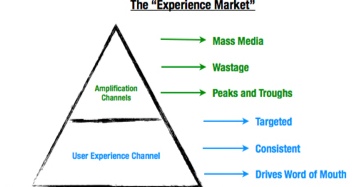 Marketers know it is vital to engage their consumers but often don’t understand the real capabilities of experiential marketing.
Marketers know it is vital to engage their consumers but often don’t understand the real capabilities of experiential marketing.
Einstein said if you do the same thing twice and expect a different result it is a sign of madness. So the question is, why are brands not understanding the full capabilities of experiential marketing?
Experiential is more than just slapping on an event and handing out a product sample and after speaking to various brand and marketing managers there seems to be two fundamental issues prohibiting this understanding.
Issue 1 – Understanding of the term experiential
The first issue seems to be that people do not fully understand the term ‘experiential’ – especially in terms of where it fits in the marketing mix and how it is should be used to achieve business goals.
Emma Pittaway, Regional Manager of United Biscuits suggests that the broad nature of the term may hold the key to the problem. She says “I think experiential as a term is one that is not massively understood maybe in terms of what it is – as it is quite a broad term. I personally see experiential as literally experiencing the brand and you can do that in so many ways.”
The role of all marketing is to deliver information to an end user. It is the distribution of that information or the channel that becomes unique. The experience channel is based on the need of the end users to experience or immerse themselves with the brand to take away or understand the message or story they are conveying. The mechanics* used are varied and adopted based on the required goal of the company. In addition, ‘experiential marketing‘ can be used in two different formats – one is at company level where the company is an experienced based company and the other at product or brand level where brand tells their story by sharing experiences with end users.
Issue 2- The role and placement of Experiential in the marketing mix
Another factor in ‘getting’ experiential may well be understanding the role and placement of experiential within a marketing communication mix.
The end receiver of the information will define how and where they take on board information. Each channel serves a purpose and some channels should be used above others for different sectors and industries. The key difference with the ‘experiential channel’ over ‘traditional channels’ such as TV, Radio and Press is how you tell your story, and that story is created based on a targeted audience rather than a mass audience.
 Experiences should form the core base of your communication, because research has proven that consumers are willing to listen to brands that don’t just offer them a product or a service, while other channels amplify the message. The diagram to the left demonstrates the difference between the two channels and how they can support each other in the marketing communication mix. The ‘User Experience Channel’ gives people experiences that are targeted, consistent and drive word of mouth while the ‘Amplification Channels’ amplify this message through the mass media, which would ordinarily generate a mass audience but a lot of wastage, and be delivered in peaks and troughs – mainly due to financial constraints. When the ‘Amplification Channels’ are used to support the ‘User Experience Channel’, the message becomes more relevant to more people.
Experiences should form the core base of your communication, because research has proven that consumers are willing to listen to brands that don’t just offer them a product or a service, while other channels amplify the message. The diagram to the left demonstrates the difference between the two channels and how they can support each other in the marketing communication mix. The ‘User Experience Channel’ gives people experiences that are targeted, consistent and drive word of mouth while the ‘Amplification Channels’ amplify this message through the mass media, which would ordinarily generate a mass audience but a lot of wastage, and be delivered in peaks and troughs – mainly due to financial constraints. When the ‘Amplification Channels’ are used to support the ‘User Experience Channel’, the message becomes more relevant to more people.
Pittaway suggests that “Using experiential in the wrong way – that is to amplify an advertising messages – means that your brand is trying to engage with consumers when it is too late.”
Pittaway continues “I am a great advocate of experiential but not everyone can adopt it because of their business culture. Some brands use it as the base of their communications strategy to great effect. Red Bull are a great example of this.”
Red Bull allow people to experience their brand by bringing it to a whole host of relevant audiences and adding value to their lives. This activity underpins their other marketing efforts, meaning that when many people see a TV spot or print advert, they already have that core engagement that they can reconnect with and re-live.
Without the correct creative, planning and logistical know-how experiential can be executed poorly and activated in the wrong part of a marketing communication strategy, reducing the impact of the campaign and ultimately ROI.
Pittaway sums up by saying “Experiencing the brand? Absolutely – that is what consumers should do. A brand is a lifestyle – if you don’t experience it you are not going to buy in to the brand. If you get experiential right, it is a really really fantastic mechanic.”
As specialist experiential marketers, we have a key role in breaking down the barriers to our trade – whether it is in defining the term, identifying the role of experiential in wider marketing strategy or just ensuring it is implemented to maximum effect throughout the process.
If you are not getting the right advice or information, contact Hotcow for a free consultation.
What is your understanding of experiential marketing? Do you agree with our thoughts? Join our LinkedIn group “Engaging Experiences” to discuss it now!
For the latest thoughts and information on experiential marketing, sign up to our monthly newsletter.
*Mechanics – this refers to the type of experience we are used to implementing based on the required outcome. For example – a PR stunt would be implemented to gain press coverage, a sampling campaign would be implemented to gain trial of product.
Hotcow is a multi-award winning brand engagement agency specialising in experiential marketing. Our mission is simple: to help brands understand the power of “experience-based marketing” and offer expertise in how to develop, plan and execute campaigns in the right way to get the right results, while showing that every pound spent is measurable. Visit www.hotcow.co.uk for more information.
